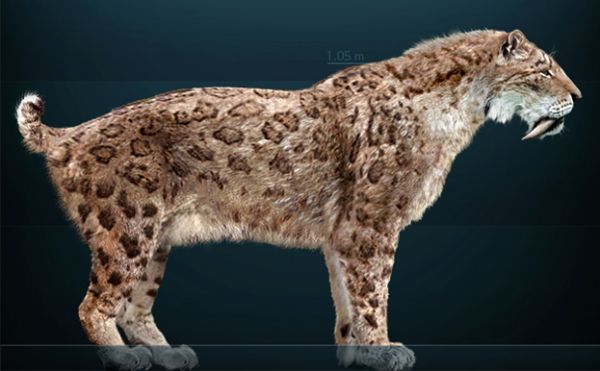
Pictured above is a recreation of
Smilodon fatalis,
the species of saber-toothed cat that is the mascot of the Page Museum
in Los Angeles. At one time, several species of sabercat roamed North
America, but they disappeared along with the other big extinct mammals
whose bones are found in the La Brea tar pits. Not fossils -millions of
actual bones that have been preserved for thousands of years in
asphalt.
Familiar or alien, all these creatures —
and many others — disappeared from North America between 50,000 and
8,000 years ago. On a human scale, this seems a long time, but in the
fossil record it marks a calamitous, rapid decline. Paleontologists and
archaeologists have invoked many possible causes for the catastrophe,
from disease and a wayward comet to climate change and hungry, hungry
humans. Today, only the latter two mechanisms are taken seriously, but
exactly how the dispersal of humans conspired with the onset of a
warmer, wetter global climate to drive so many species to extinction is
still fiercely debated. Figuring out how the disaster played out is
critical to understanding the future of life on Earth. This was not a
just a last stand of Ice Age animals against the beginning of the
Anthropocene, or age of humans. The extinction of the megamammals is
part of a drawn-out process that continues to tatter and imperil what’s
left of the planet’s wilderness.
Most scientists have believed
that, as the mammoths, horses and bison of the Ice Age disappeared —
whether killed by humans in need of meat, by habitat loss, or by a
combination of factors — the abundant populations of Smilodon simply ran
out of food on the hoof. Jaguars, grey wolves and other carnivores
survived, but North America’s last sabercat apparently could not cope
with the changes that arrived at the close of the Pleistocene.
Research
in the tar pits has shifted from finding the largest and weirdest
animals 100 years ago to preserving all the evidence of prehistoric
creatures, no matter how small, in order to build a more complete
picture of the ancient environment that may give us more clues as to why
Smilodon is no longer with us. Aeon magazine has
an article about the sabercats and what we know about them, including how our knowledge of them has changed over the past few decades.
 Pictured above is a recreation of Smilodon fatalis,
the species of saber-toothed cat that is the mascot of the Page Museum
in Los Angeles. At one time, several species of sabercat roamed North
America, but they disappeared along with the other big extinct mammals
whose bones are found in the La Brea tar pits. Not fossils -millions of
actual bones that have been preserved for thousands of years in
asphalt.
Pictured above is a recreation of Smilodon fatalis,
the species of saber-toothed cat that is the mascot of the Page Museum
in Los Angeles. At one time, several species of sabercat roamed North
America, but they disappeared along with the other big extinct mammals
whose bones are found in the La Brea tar pits. Not fossils -millions of
actual bones that have been preserved for thousands of years in
asphalt. 
No comments:
Post a Comment